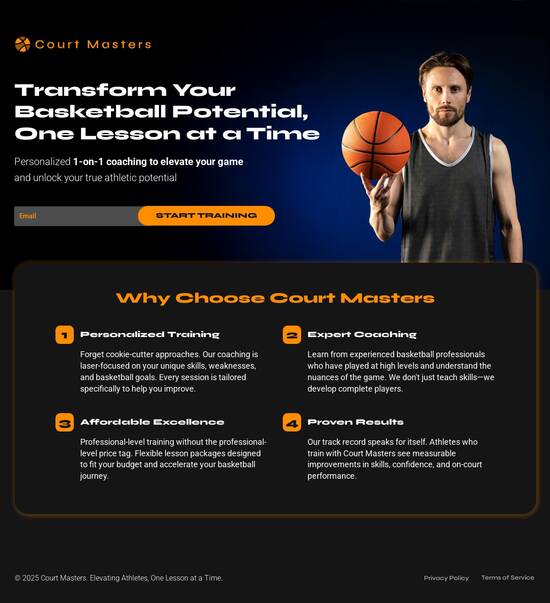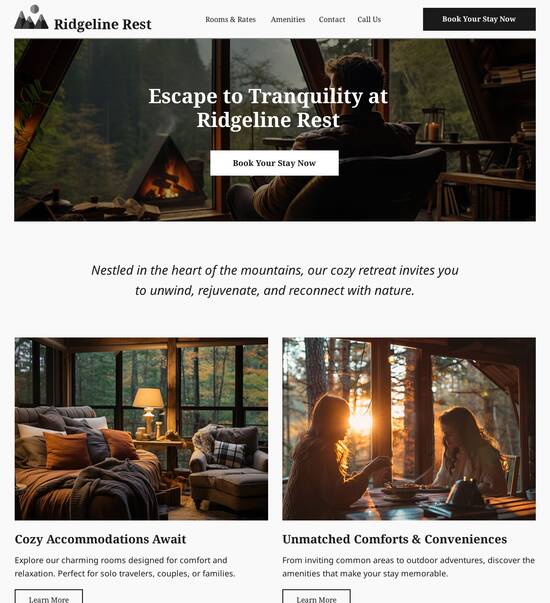
HTML/CSS optimized blog home page template
Explore Similar TemplatesAbout template
Supercharge your blog home page with HTML/CSS for outstanding performance! Learn more today.
Recommended templates

Easy to build without coding
With the intuitive drag-and-drop builder, anyone on your team can create high-converting pages without any knowledge of code or design. Make enhancements to your landing page with custom widgets using Javascript, HTML/CSS, or third-party scripts.

Multiple layouts for any industry and goal
Select from 500+ landing page layouts built to boost conversions across industry-specific scenarios. Customize them by adjusting fonts, adding images, and generating on-brand content with the AI assistant. Quickly scale with Instablocks® and Global Blocks that you can save, reuse, and update globally.

Loads fast and looks polished on any device
Every template is responsive, which means they present professionally on any device and load blazingly fast with our Thor Render Engine. You can also power them up with Google AMP technology to deliver an unparalleled mobile experience and drive higher conversions.

Robust analytics & experimentation
Get real-time updates and reporting across all your devices, showing the number of visitors, conversions, cost-per-visitor, and cost-per-lead. Launch AI-powered experiments, run A/B tests, and use heatmaps to analyze user behavior, then optimize your landing page to maximize conversions.







Easy to build without coding
With the intuitive drag-and-drop builder, anyone on your team can create high-converting pages without any knowledge of code or design. Make enhancements to your landing page with custom widgets using Javascript, HTML/CSS, or third-party scripts.
Multiple layouts for any industry and goal
Select from 500+ landing page layouts built to boost conversions across industry-specific scenarios. Customize them by adjusting fonts, adding images, and generating on-brand content with the AI assistant. Quickly scale with Instablocks® and Global Blocks that you can save, reuse, and update globally.
Loads fast and looks polished on any device
Every template is responsive, which means they present professionally on any device and load blazingly fast with our Thor Render Engine.
Robust analytics & experimentation
Get real-time updates and reporting across all your devices, showing the number of visitors, conversions, cost-per-visitor, and cost-per-lead. Launch AI-powered experiments, run A/B tests, and use heatmaps to analyze user behavior, then optimize your landing page to maximize conversions.
All the features you need to build lead-generating landing pages
Explore more featuresLearn how to build top-performing landing pages for any goal
FAQs
Leading the way in building high-performing landing pages





A powerful landing page and CRO platform for effective marketing
Instapage stands out as the most effective solution for creating landing pages that dramatically boost conversion rates and maximize the return on investment for digital marketing campaigns. The platform's usability is perfect for marketers across various sectors, including business services, tech, and education.
Getting Started with Instapage
To embark on your journey with Instapage, first, you must create an account. The onboarding process is straightforward, allowing users to quickly familiarize themselves with the extensive array of tools and features that Instapage provides. This step is crucial for harnessing the platform's capabilities fully.
- Access customizable templates: Choose from over 100 high-converting layouts tailored for different business needs and industries.
- Utilize the drag-and-drop builder: This intuitive tool allows you to create beautiful landing pages with ease, requiring no technical knowledge.
- Integrate third-party tools: Connect your existing marketing and analytics tools for streamlined operations and better data tracking.
Creating Your First Landing Page
Once you have an account, it’s time to create your first landing page. This involves selecting a template that aligns with your campaign goals and customizing it to fit your brand's unique style.
- Select a template: Review the library to find a layout that resonates with your marketing strategy.
- Add elements: Use pre-built lead generation components like forms and call-to-action buttons to increase engagement.
- Personalize content: Incorporate dynamic text replacement to tailor messages for specific audience segments.
Optimizing for Performance
After launching your landing page, the next step is optimization. Continuous improvement is necessary to increase conversion rates and eye-tracking efficiency.
- Conduct A/B testing: Analyze different versions of your landing page to determine which performs better.
- Utilize heatmaps: Gain insights into user behavior on your page to identify what captures attention.
- Monitor analytics: Use the built-in dashboard to track conversions, bounce rates, and other performance metrics to adjust strategies accordingly.
With these steps, you're well on your way to leveraging Instapage for your marketing success. The platform's features and tools are designed to empower marketers.
By implementing these strategies, you will not only enhance user engagement but also maximize campaign success. Instapage simplifies the creation of high-performing landing pages even for small teams with diverse budgets.
Start using Instapage today to rapidly create landing pages that convert. Take advantage of its powerful features to improve your marketing strategy and see noticeable results.
People also ask about HTML/CSS optimized blog home page template
HTML/CSS optimized blog home page template
Understanding the essentials of an HTML/CSS optimized blog home page template
Creating a blog is an exciting journey, and the home page of your blog serves as the virtual storefront. It is the first point of interaction for your visitors and can significantly impact their overall experience. In this guide, we will explore various aspects of an HTML/CSS optimized blog home page template, focusing on enhancing performance, user engagement, and aesthetics. By understanding the foundational elements of a well-structured blog home page, both beginners and seasoned web developers can create effective and appealing blogs.
The importance of an optimized blog home page
A blog home page plays a crucial role in showcasing your latest content, establishing your brand identity, and captivating visitors to keep them engaged. An optimized blog home page not only attracts users but also improves their experience through faster loading times and intuitive navigation. According to various studies, website performance affects user engagement, with approximately 47% of users expecting a page to load in two seconds or less. To remain relevant, bloggers must prioritize these aspects to retain readership.
A well-designed home page enhances user satisfaction, encouraging visitors to return.
Optimal performance leads to higher search engine rankings, increasing visibility.
Improved loading times can significantly reduce bounce rates, keeping readers engaged.
Key features of an HTML/CSS optimized blog home page template
An effective HTML/CSS blog home page template will include several vital features, ensuring that both the functionality and aesthetics align with user expectations. First and foremost, responsive design is essential. This means that the layout adapts seamlessly to various devices and screen sizes, providing a consistent experience whether users are browsing on mobile phones, tablets, or desktops.
Implement fluid layouts that resize proportionally based on screen size.
Utilize CSS media queries to adjust styles according to device characteristics.
Additionally, a clean and semantic HTML structure is crucial for Search Engine Optimization (SEO). This involves using well-defined tags and organizing content effectively, making it easier for search engines to understand the context of your content. Essential elements to include are the header, footer, main content section, and a sidebar, all laid out with user experience in mind.
Lastly, CSS flexibility allows for visually appealing designs while maintaining a light footprint. Utilizing CSS Flexbox and Grid layouts can help achieve optimal spacing and effortless alignment of content elements. This not only contributes to the aesthetics of your blog but also facilitates easy updates and changes in the future.
Tailoring your blog home page for different audiences
Understanding your audience is key to effective blogging. For beginners, simplified navigation and user-friendly interfaces are paramount to facilitate entry into the blogging world. This might include having prominent category links, a search bar, and clear call-to-action buttons. Essential features, such as links to essential resources, easy to navigate menus, and straightforward layouts, can make a significant difference in user interaction.
Design the navigation bar intuitively to help beginners find what they need effortlessly.
Incorporate tutorials or guides that assist novice webmasters.
For advanced users, customization and scalability capabilities should be emphasized. This not only allows experienced bloggers to modify the template to better fit their advanced needs but also to integrate their blogs with popular content management systems efficiently. Ensuring that visual design elements balance aesthetics with usability is essential across all skill levels, maintaining a clean and engaging interface.
Essential elements and components of the template
An HTML/CSS optimized blog home page should encompass several essential elements and components to ensure effective communication with readers. The header and navigation bar stand at the forefront, where best practices focus on user engagement strategies. This may involve strategically positioning the navigation bar and ensuring it follows a logical structure for easy access to different sections of your blog.
Utilize dropdown menus to categorize content effectively.
Ensure clear and inviting call-to-action buttons in the header.
The content section would benefit from a grid system for optimizing post layout, allowing for a visually appealing arrangement of articles. Featured images and excerpts should be included to entice readers. Furthermore, sidebar widgets can be a valuable asset for promoting your products and services while also integrating social media feeds and email subscription options.
Lastly, the footer design must incorporate crucial elements for additional navigation, such as links to privacy policies, terms of service, or contact pages. Enhancements such as copyright notices and social media links serve to not only inform visitors but also foster a sense of connection and community.
Optimizing performance for a broader reach
To ensure your blog reaches a wider audience, optimizing performance is crucial. Enhancing loading speed serves as a top priority, as slow-loading pages can deter many users from staying on your site. Implementing minification and compression practices for HTML and CSS can significantly streamline the loading process. Additionally, employing image optimization techniques, such as utilizing WebP format or resizing images appropriately, can also result in faster load times.
Reduce file sizes of CSS and JavaScript files by removing unnecessary characters and spaces.
Consider lazy-loading images so that they only load when they enter the viewport.
Moreover, adhering to SEO best practices while coding can enhance your blog’s visibility in search engines. Utilizing descriptive tags and attributes, alongside ideating effective meta descriptions, lays a strong foundation for improved rankings. Implementing structured data and schema markup provides additional information about your content to search engines, potentially garnering rich snippets in search results, further enticing clicks.
Skills required for effective implementation
A solid foundation in HTML and CSS is essential for anyone looking to create an HTML/CSS optimized blog home page template. Bloggers should familiarize themselves with fundamental tags and styles that are crucial for effective web development. Learning through practical tutorials can help build confidence and proficiency in coding concepts.
Understanding of document structure and layout elements like header, footer, and sections.
A grasp of CSS concepts such as selectors, properties, and responsive design principles.
For those looking to further hone their skills, exploring advanced techniques for creative design is beneficial. Using responsive frameworks can offer greater flexibility in design, while integrating JavaScript can enable dynamic content functionality, enriching the user experience.
Creating your blog template: step-by-step guide
Establishing your blog template starts with setting up your environment. Identifying the right tools and software for development is crucial, as they serve as the bedrock for your coding process. Choosing a code editor such as Visual Studio Code or Sublime Text can streamline coding by providing helpful features such as syntax highlighting, error-checking, and auto-completion.
Install essential software like Git for version control.
Leverage plugins for enhanced efficiency in your chosen code editor.
The development process should begin by initializing the HTML layout and styling with CSS. Iteratively adding components while observing how each change affects the layout can help solidify your understanding of design and functionality. If necessary, incorporating external libraries, such as Bootstrap or Tailwind CSS, can significantly enhance your design capabilities.
After creating the initial layout, it is essential to test and iterate on the design. Strategies for effective testing should include checking across multiple browsers to ensure compatibility. Identifying common issues, such as misalignment or broken links, and resolving them will ultimately enhance the overall user experience.
Exercises and practical applications
Hands-on testing of features can significantly elevate the learning experience for both novice and experienced distillers of blog templates. For beginners, engaging in group exercises encourages collaboration and solidifies understanding of fundamental concepts. Meanwhile, professionals can challenge themselves with projects that push their creative boundaries, such as incorporating advanced effects or integrating various external services.
Create a basic blog template with a focus on responsive design principles.
Implement a CSS Flexbox layout to experiment with element positioning.
Reflective questions can also provide inquiries into how layout changes might impact user behavior. Asking yourself what long-term benefits might arise from a well-optimized page can illuminate the importance of continuous refinement in web development.
Measuring success and understanding user interaction
To gauge how effectively your blog caters to its audience, employing analytics tools is vital. Services like Google Analytics or other similar platforms allow you to monitor user engagement, tracking metrics such as page views, session duration, and bounce rates. Understanding these key metrics can provide invaluable insights, enabling you to adjust your content strategies effectively.
Utilize heat maps to understand where users interact most on your page.
Analyze traffic sources to better understand how visitors find your blog.
Additionally, fostering a culture of iterative improvement based on user feedback can significantly enhance your blog's responsiveness to visitor preferences. Regularly utilizing surveys and feedback forms can help gather insights about user expectations and areas of dissatisfaction.
Evolving your template for future trends
As user behavior continues to shift, particularly with a growing inclination toward mobile usage, adapting your blog template to meet these changing needs is essential. Keeping abreast of design trends and preferences alongside technological advancements can help ensure your blog remains relevant and visually appealing.
Regularly update your design based on user feedback and performance data.
Explore new tools and technologies that can enhance user experience.
Building a community around your blog can also enhance user interaction. By engaging with your audience through social media platforms, you can create a space where discussions thrive. Encouraging user-generated content not only fosters connection but also can lead to increased loyalty and sustained traffic.
Ready to skyrocket conversions?
Supercharge your ad campaigns with high-performing landing pages
Get started














